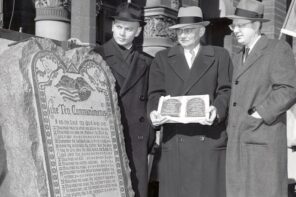On New Year’s day, Peter Steinfels posted his last “Beliefs” column for the New York Times. Reviewing twenty years of occasional commentary, he reflected on the polarization of American religious rhetoric:
Not only abortion and older questions of public morality and church-state relations, recently heightened by the political mobilization of conservative believers, but also newer issues like embryonic stem-cell research, physician-assisted suicide, and same-sex marriage, have pitted significant elements of traditional Christianity, Judaism, Islam and other faiths against leading voices of political and cultural liberalism.
I don’t know whether Steinfels is right about increasing polarization across all traditions and topics. It’s as much as I can do to keep up with Christian debates around sex. But I can see that Steinfels gets one thing right, if unintentionally. He deploys the most familiar rhetorical device from the last two decades of church debates: the fight is between “significant elements of traditional Christianity” and “political and cultural liberalism.” Religious tradition against secular liberalism: Steinfels’ neat divide has been immensely useful for those on the “traditional” side. Of course, the division is also misleading—to use no stronger word. It depends on two sleights-of-hand. First, Steinfels has to forget that “significant elements” of Christianity hold, often for traditional reasons, that same-sex marriage is religiously justified—indeed, that refusing it constitutes a religious fault. Then Steinfels has to ignore all the ways in which current “traditional” positions aren’t traditional at all.
The first trick is easier to catch than the second. While there are of course figures who criticize church teachings on “cultural and political” grounds, there have been for half a century now dozens of theological and historical writers in favor of changing those teachings. Those writers don’t take themselves to be resorting to secular principles to make their arguments. Indeed, they have frequently been critical of social views toward gender and sexuality.
Take Sherwin Bailey, who published Homosexuality and the Western Christian Tradition more than fifty years ago—thirty years before Steinfels began his column. As a writer and church lecturer, Bailey helped lead the Church of England to review its teaching on homosexuality. An Anglican priest, a pastor, and a historian, he had theological reasons for thinking the churches should change their teaching on sex, some of them drawn from new medical or psychological discoveries. But he also knew—he meticulously argued—that “traditional” church teachings on sex had themselves been cobbled together over centuries out of dubious material: misreadings of biblical passages, undisguised social prejudices, fantasies masquerading as science. When “significant elements” of the Church of England began to change their view on homosexuality, it wasn’t because they wanted to throw over religious tradition in order to embrace some passing secular trend. It was because they had been led, for religious reasons, to reexamine what was being claimed as traditional.
Bailey’s story has been repeated many times in the last fifty years. It’s impossible even to summarize all the teaching, writing, and preaching that has gone into distinguishing the core of Christian traditions from their accretions and deformations. What we are living through is not a fight between a pristine Christianity and the encroaching world, but a divide within Christianity over what exactly should count as tradition. It isn’t a fight between religious conservatives and activist revolutionaries. It is a deep disagreement inside Christianity over what conserving faithfulness means.
You wouldn’t know this reading Steinfels’ description of our recent debates. To be fair, he is hardly alone. Most reporting of religious debates over sexuality, whether in the Times or on the wire services, assumes the same division—or performs the same sleights-of-hand. When self-proclaimed “traditional” voices are quoted against same-sex marriage, they are allowed to claim scriptural evidence, church history, and even the name “Christian.” When other Christian clergy or believers are quoted in support of same-sex marriage, they become “activists” who are allowed only to speak about civil rights or fairness or—sometimes—wispy Christian principles, but not about scripture or church history or faith itself.
I used to think that this was the fault of progressives—that we reverted too often to the bland language of fairness, toleration, or rights. So I tried always to give reporters scriptural and historical arguments. They rarely found their way into print. I wondered whether the forced simplification of religious journalism had a built-in bias for obvious, “literal” readings of scripture. Or whether the need to tell a story—to sell a story—drove reporters back to the familiar plot: venerable belief versus modern liberalism. So I began to experiment with saying very traditional religious things in interviews.
“I support ordaining openly lesbian and gay candidates because that’s where I’m led when I study scripture and pray.”
“My belief in incarnation pushes me toward the blessing of same-sex unions.”
The reaction was mostly awkward silence. I could hear the typing stop at the other end of the line.
So I decided to attack the assumed familiar plot directly—to go after the division, enshrined by Steinfels, between tradition and innovation. I began to tell reporters what I fully believe: no present church position on sexuality would be recognizable to Christian writers of two hundred years ago—much less two millennia ago. Part of the reason is that the basic terms and psychological models have changed astonishingly in the last century. All Christian writers, even the most “traditional,” assume the existence of things (like “sexuality”) and mechanisms (like the unconscious) that are neither scriptural nor traditional. But the more striking difference is the scope contemporary “traditionalists” give to sexual pleasure in marriage. Evangelical writers famous for attacking homosexuality write pillow books for Christian newlyweds advocating sexual techniques that church traditions classify as unchaste and unnatural—indeed, as acts of sodomy.
What Steinfels and many other journalists label “traditional Christianity” is, when it comes to sex, actually an all too modern selection and rearrangement of a few old elements detached from the contexts and practices that gave them meaning. The claim for tradition amounts to repeating a few old formulas of condemnation, while the other teaching drops away. This isn’t a tradition. This is violently selective repetition—an ongoing revenge on tradition.
No reporter has yet bought my story. I don’t expect that Steinfels would. But I am bold enough to suggest—to plead—that he use at least a little of his new leisure to reconsider the storyline he’s been following for the last twenty years. It’s not a story about the debate so much as a position within it.




